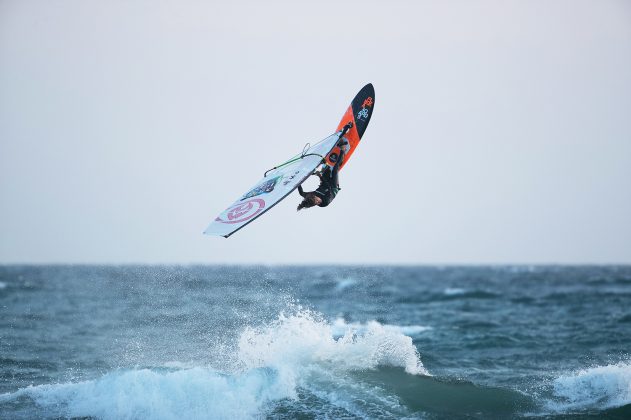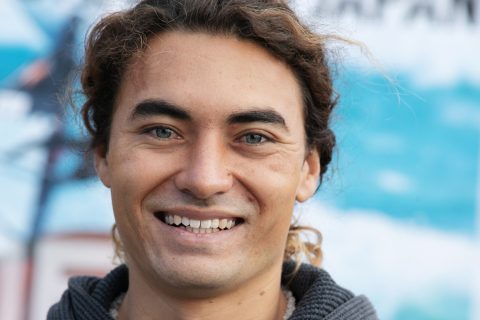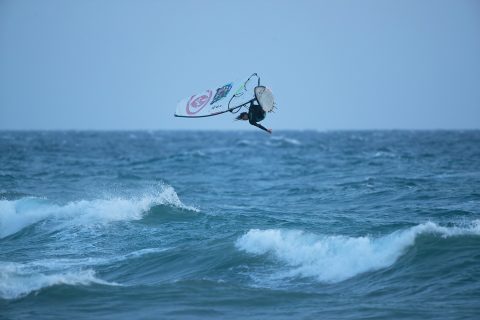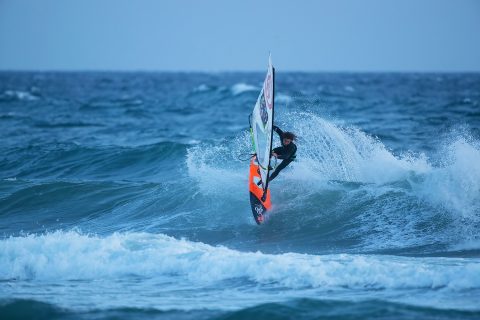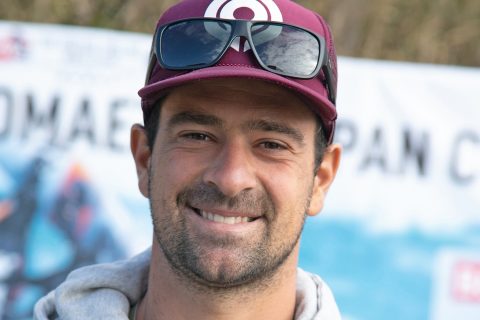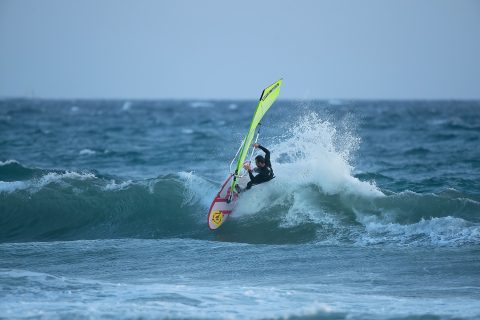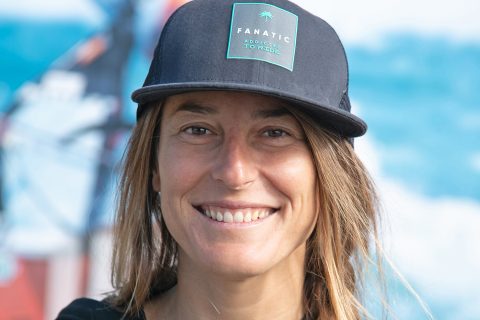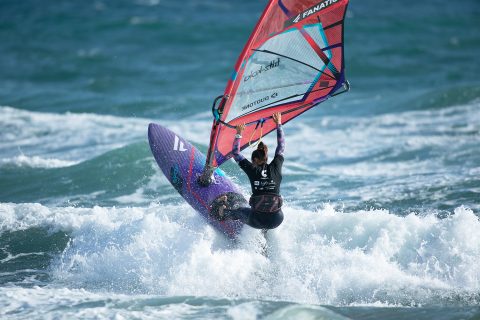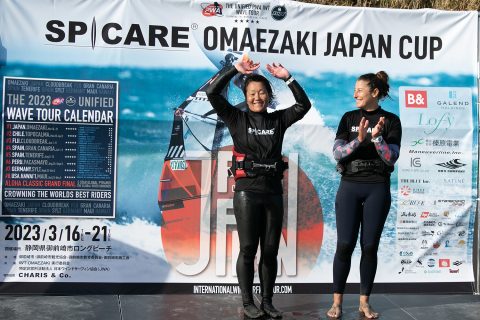PWA JAPAN: OMAEZAKI’S RETURN
The Spicare Omaezaki Japan World Cup in March, marked not just a return to the famous waves of Omaezaki, but the start of the new unified IWT/PWA world tour. Bernd Roediger, Marcilio Browne and Maria Andrés give us their thoughts on an event that made a lasting impression.
WORDS – Bernd Roediger, Marcilio Browne and Maria Andrés // PHOTOS – Harry / pwaworldtour.com
Bernd Roediger
- Bernd Roediger
Hermione Granger states, in my favourite Harry Potter book, “The Goblet of Fire”, that competition is cooperation. “This whole tournament’s supposed to be about getting to know foreign wizards and making friends with them!” she proclaims one evening, after an unearned rousting from an isolationist Ronald Weasley, who’s insecurities and jealousies have made him invariably tribalistic, and untrusting of wizards from outside of the UK. At the time of reading his book, I was just starting to get into wavesailing competition. Competing against people older than me, more capable, and more accustomed to a tour life/scene that seemed bizarre and propped-up to me. I harboured a lot of confusion about competition, that I perpetuated throughout my young adult life. When I was feeling confused about the wedges my sport, my love and passion, was driving between me and the human beings who shared this love, who just happened to be in a heat with me, I would think about that fantasy world of Hogwarts. Where a more nuanced representation of the competitive spirit unfolded in a kind of parable.
- Bernd Roediger back loop
Profound
In a fantasy like Harry Potter, the mythic explains the mundane, and the significance and meaning of commonplace morality is often elevated; made into a magical spell for remedying the complex obscurity of grey ol’ life. The maxim presented in such a notion as ‘competition is cooperation’ works to harmonize discordant opposites in philosophical alchemy. It makes of a thing, more than the sum of its parts, and is therefore beautiful. Such is the experience in Japan, if ever you have the good fortune to go, and see for yourself the way in which an elimination event can be made into something profoundly cooperative and supportive. People make real friends out there, and every year the friendships grow in span and depth. Through this event I‘ve come to know a handful of fantastic Japanese sailors that I genuinely miss, not just when leaving Omaezaki, but often throughout the year.
Common ground
When I first arrived in Tokyo, a friend of mine, Molishan was there to pick me up and drive me the 4+ hours south to Omaezaki. We played guitar together in 2019, when we couldn’t have a conversation in either of our native languages. He’s spent time in the past three years taking English lessons, working evenings so he can windsurf every day, and planning this 2023 event for the opportunity to share in those meaningful friendships. There’s pro riders that I’ll admit I wasn’t ever really close to until I ‘met them’ in Omaezaki. Even people whom I share my home island with. In 2019, I found a common sense of humour in Jake Schettewi that I did not expect. I became better friends with Antoine Martin and let our IWT competitive tension rise into a creative mutual blossoming as bright as the Sakura branches at that time of year, laden with the pureness of fraternity.
Unified
2023 is markedly special in that the PWA and IWT tours are finally unified. Japan was host to both sets of riders, for the first time together outside of Maui. Real strides were made in a previously adversarial relationship I had with Ricardo Campello, something that wouldn’t have happened if we hadn’t been pushed together in a foreign place outside either of our comfort zones. And PWA riders whom I had only briefly encountered in Cabo Verde became compadres in Japan.
And the chemistry for this melding is really simple: get all the riders in buses together, going down to the beach together/sailing together, spending off-days exploring and adventuring – even snowboarding – together, eating at the same conveyor-belt sushi joints together, and you’ll achieve progress in unification! Too many events have been too focused on what differentiates riders, which makes people guarded and reclusive. I’ve been to contests where people hide from one another in an effort to self-contain, leading up to race-day. I just think our sport is too small for that, it needs intimacy like a flame needs fanning. I like the Omaezaki Japan Cup and its emphasis on the athletes as a body of professional representatives, we all go to the same promotional events, all of us there at the same signings, the same public elementary schools.
There are a lot of folks speculating on the Unified Wave Tour as just a bigger, more expensive, mashup of two tours; spread out farther making it more difficult for anyone to follow or attend. I see that view as looking at the new tour as the sum of both the old tour’s constituent parts, when Japan has shown that it is really the amplification of their respective strengths.
- Bernd Roediger slash
Fraternity
The PWA undoubtedly brings a level of professionalism, objectivity and real-world power to us (us as in the Pacific-centric wavesailors like myself) where it had previously been concentrated on the European side of the “windsurfing world”. Something I got a taste of in Cabo Verde. The IWT champions that human quality so prevalent in Omaezaki, but found in Chile, Fiji, and of course on Maui. This is because we have generally encouraged a confederacy of local organizers and strongly encouraged amateur participation. Seeing the two finally interwoven, strengthening the fabric of our interdependent sport; seeing athletes from either hemisphere of windsurfing enjoying the benefits of the other, I am heartened, and optimistic about wavesailing competition, like never before! And I feel like that magical moral lesson of The Goblet of Fire, that so captivated my sense of competition, it has finally manifest in my own world! WE are going to celebrate wavesailing this year!
I emphasize this quality of fraternity as the winning element of Omaezaki, because there was no definitive winner! And what a fitting place to leave things on the first leg of the new tour! The wind was about the only thing in the contest that was uncooperative, a bit unfriendly really. There when we arrived, dipping out when the competition window opened. Not returning but for one day of sailing, and sending us home with little to show for our efforts, but 2 rounds of competition. Those 2 rounds, that one day, we just had to run.
Debate
Interestingly, there was much debate among the sailors as to whether the Pro men should compete. People were split as to whether the conditions were good enough to be contested in, and quickly formed into two camps. In one camp, comprised largely of PWA riders, the consensus was not to run. But there was a contingency on the other side, a lot of IWT riders and local Japanese sailors, saying different; while they acknowledged that the conditions were marginal and almost incontestable, there was a spirit to drive ahead and complete the event for windsurfing, particularly Omaezaki windsurfing. On that day, in that hour, I found all my apprehensions surfacing. About competition, about bringing these hemispheres together. Mixing two attitudes that seemed irreconcilable.
The PWA riders undoubtedly held the valid stance of objectivity, in seeing the conditions for the snooze-fest that they were. Understandably, running in such conditions introduced a level of uncertainty in the result; of course the ocean is always unpredictable, thus the reason for actually sailing the heat on the day. Still, there’s a level of inconsistency in waves and wind that even seasoned competitive sailors are uncomfortable with, because the result of the heat might not reflect the skill of the rider but really the luck of ‘who got the one wave that came’.
I think that the riders who either lived in the area – who were a part of that community, or took part in the event in years prior – were possessed with a kind of sentimentality toward running, regardless of conditions. Ideally, we would have offshores and throaty ‘shorepound’ rollers to punt off of in style! Regardless of oceanic energy, the communal human energy was high, and raring to go. Since the last international event to reach these shores was back in 2019, and so much had happened between now and then, there was a sense of necessity to having something, anything, happen as a result of the – not just months but years – of collective hoping and planning for windsurfing to once again shine and dazzle these waters.
These two camps debated as the wind and waves rose, proving that the sport of wavesailing is incredibly democratic, but also incredibly divided. There’s constant debate among the athletes as to how to run, when to run, for how long and what to count. This happens on a micro and macro level in the sport, whether it be small differences in preference to run on a given day, or big differences of opinion about what events should count on a world tour. This is the first ever IWT/PWA cooperative event, outside of Maui, something that has taken years to see to fruition. While the Omaezaki Japan Cup represents a new level of unity in the sport, it also brings together the disparate ends of a sport divided into two hemispheres. The European, PWA side; and the IWT, Western/Pacific, side. These groups of windsurfers have very different approaches, careers, and styles. Of course they will not always share the same values and opinions, therein lies the new challenge we are tackling as a unified tour!
Though the ultimate decision is always up to the Head Judge, Duncan Coombs, he undoubtedly factors in the general consensus of the field of riders. The same goes for our tour directors, Simeon Glasson and Rich Page. It will come down to their joint efforts in accommodating and communicating with both PWA and IWT athletes, local organizers and sponsors to see our sport transition from duplicities to harmonies.
Special
Ultimately the call was made to run, and I took my leave of debating on the hilltop to rig and prepare in the valley/parking lot below. Descending from that high speculative place, I walked among the people, as it were. Omaezaki is special because Japanese windsurfers are special; this contest resembles a kind of extended family reunion. Tents representing every brand are pitched up in the lot, underneath are little groups drinking tea together and sharing snacks; each group is a flowing and fluxing coagulation of friends and families from different areas in Japan, reps from various brands exchanging stories about their part of the country and the conditions; their businesses and personal relationships mingling harmoniously. The piles of gear (that pros bring in by the van-load) serving as enclosures for intimate gathering. My favourite part about this ‘event within the event’ is that no one is really watching the conditions minute-to-minute. They’re watching each other, this time of the year being their moment to check in on one another. I can’t imagine that windsurf retailers make up a sizable portion of the Japanese populous, and it is likely that these folks are seen as uncouth, living unorthodox lives centered around a passion amidst the strict traditions of their society.
Molishan
I see my fiend, Molishan, in a gathering around a picnic table of rice cracker treats; he and his wife drove to Tokyo and back, twice, (a trip that is 4 hours each way) just to shuttle athletes and gear from the airport to the event. Molishan owns his own classic car garage, he sails religiously, taking many of the prime business hours of the day off to get on the water. He also tries to snowboard each weekend with his wife; Molishan is a hero among men, but of course not your typical Japanese working class family man. Among them he probably does not find fraternity. His people are us. He looks forward to the day when like-minds come to visit and share stories from sessions sailed around the world. As his wife drove their box truck out of Narita Airport, Molishan chronicled for me the time between the last Omaezaki Japan Cup (2019) and now. Everything that happened, the pandemic, lockdown, cancellations and isolations, a 2022 event closed to international athletes, a local community isolated from their international friends… He wears an event t-shirt from the “2020 Omaezaki Japan Cup”, that never happened, and was cancelled mere weeks before it was set to run; and I can see that this is a living event that has been both missed and mourned. And I wonder if any other event is so strongly felt by its participants and organizers?
I mean, Cabo Verde made my year, my life! To be there was to realize a dream, to act out a movie I’d been playing nonstop since I was 12. But it’s not happening this year, and I’m ok with it, because something like that doesn’t need to happen every single year. But Omaezaki, a place where friends meet, that is required, that is of the utmost importance.
Validation
And so we ran our heats, everyone jumping wildly and waveriding with spectacular skill. It was no banner day for the level of pro windsurfing, pushing the limits of what is possible for the best of the best. But, it served the fans of this Omaezaki Japan Cup, it gave them validation for the years of hard work and sacrifice that it took to resurrect this event. I am so thankful to be back here, thankful to passionate windsurfers who envision these gatherings, and commit to making them happen. This family congregation is the perfect starting point for a unified IWT/PWA tour, a place where we can reconnect with the roots of the beautiful tradition of windsurfing. It’s my hope that the rest of this year, this tour, carries with it the spirit that thrives in Omaezaki.
Kit
A word about my own equipment, as it compares to others. I ride, generally, the same gear wherever I go. Partly, that is because if I need wildly different gear for a location, I am probably not seriously considering going there; though I do admit that mentality is very limited. I hope to change it this season, venturing outside my comfort zone, perhaps to Sylt this year! Already I have worked with Flikka to develop a board for smaller, less powerful surf; perfect for the conditions we had! This is a board that I would still enjoy riding, not just something created out of necessity for events. I don’t really value utility as much as other pros, you can see that in how my quiver of sails and boards is often smaller than that of others. Anyways, I need fun to feel engaged, and I’m really happy that I was able to get a tool that’s both fun and effective from Flikka! It was ideal for a day just like what we had in Omaezaki. The length of this board is 215 cm, which is short even for me, and its fuller outline, combined with alternative contours, created something playful, refreshing, stylized. I actually really enjoy small wave surfing and windsurfing; I just want that fun-factor to remain constant, though it takes on a different form. Under the board were a pair of prototype quad fins from Black Project, designed for Phillip Köster. I love watching Philip sail because he’s this big guy that dances on the water like a ballerina bear. He’s so light on his feet, so sensitive and reactive. These “onshore” fins have a really springy quality that matches my style and board nicely. They’re the link I use to translate what I love to do in offshores to the onshore conditions we find on tour-stops like Omaezaki. So riding those fins gave me quite a bit of confidence to go for a Taka on a really tricky section, as well as the liveliness to stick it despite the sketchy landing. I also paired this setup with the right sail, using a 4.5 SuperFreak throughout the competition. It’s the first time I’ve used a SuperFreak in an event, though I’ve been free-sailing on them for a few years now. I am probably one of the sillier riders on tour, in terms of the things I like to do on the wave, and that freedom from convention is the primary virtue of the SuperFreak. I must’ve known, through E.S.P., that there’d be light winds, because I brought my 4.5 in to local Maui artist, Judie Vivian, to have a wonderful tiger painted on the very fabric of the sail; along with my ancestral Japanese surname: Takagi, which means “High Tree” family.
Family
There are many Takagi cousins of mine living in Kobe, and here in America there’s my Obaasan, who immigrated in the 1960s. Until that time she was practicing the Shinto faith, and she once confessed to me that her initial encounter with the Judeo/Christian tradition came from watching the film “The Ten Commandments: with Charlton Heston. An anecdotal reminder that we choose our stories, even our religious beliefs, in odd ways; influenced by art, aesthetics, affinity and fascination. For me, I look at the way in which many cultures, and notably in Shinto, use animal spirits to embody – or serve to represent- natural phenomena. The tiger‘s form, it’s slow, measured, confident pacing, is sometimes associated with the movement of broad and sweeping rivers flowing into the sea; inevitability we westerners might term this as “Providence”. Like a river: time, entropy, destiny are all quietly fulfilled in the way a tiger silently stalks and acquires prey in the twilight hours of the dimly illumined jungle. As a far-flung fringe of the Takagi family partaking in a destiny that inevitably leads back to the ancestral country, I felt a very strong resonancy with this notion of a tiger.
Marcilio Browne
- Marcilio Browne
Having Japan back on the calendar was great news. I had heard of this location many times before, always positive things, but the last full-on world cup event that took place there was in the 90s, so I actually had never been to Omaezaki before. So before the contest the only way I could find to understand the spot was by searching on YouTube. I tried to watch as many videos as possible to understand the place and tried to see all the different scenarios, wind angles, swell angles etc. Luckily, right before the event, Maui seemed to have really similar conditions, side-onshore winds with east swells for about 2 weeks, so I was able to get some proper practice for the event without leaving home.
- Marcilio Browne ripping in Japan
Equipped
I took sails from 3.7 up to 5.7, and 2 sets of boards. One set was 3 sizes of the same boards I ride here on Maui, all quads – a small 84-litre, medium 89-litre and large 94-litre, in case the conditions got pretty decent and side-shore, like I saw on YouTube. I also had 3 other boards for really marginal conditions, they were my 3 Nitros – a small 84-litre prototype, medium 89-litre and a large 98-litre. That way I felt pretty covered for what ever we were going to get. On my quads I pretty much ride KS model 14.5 cm and 9 cm from MFC and for my bigger quad I had this new fin prototype that was a new shape with a bit more power, also from MFC. On my Nitros I ride them as thrusters – 17/11 on the 84, 18/11 on the medium and 18/12 on the bigger board.
Forecast
So a few days before the event we saw a little forecast appear on Windguru, and I changed my flight to head there 2 days early and get a session in. That session was really fun and it was great to get a better understanding of the spot. It started off really light, with 5.0 and 92-litre board, but as the day progressed it got windier and windier. By the end of the day we were riding 4.2’s and 84-litre boards. The wind was side-shore with heard high waves, really fun going frontside, trying tricks and jumps, and it was also fun to be back sailing with all the other competitors after a couple of months.
After that the forecast kind of took a dive, and from early on it was clear that we needed something close to a miracle in order to compete. We were still in this new place surrounded by amazing people, so some of the local guys offered to take us snowboarding. It was quite a mission, 4-hours drive each way, but totally worth it as we ate great food, hung out, and the snow was pretty decent too. The best part was that it was super uncrowded. It was nice to hear it was the first time ever on the snow for Ricardo Campello and Antoine Martin and they picked it up right away.
I really loved meeting all the people there, everyone was so friendly, welcoming and really made me look forward to coming back next year. The funniest part for me was ordering food on iPads and getting it delivered by full on robots, I’d never seen that before, ha ha. Also it was so funny how many different options of water jets the toilets provided!
Maria Andrés
- Maria Andrés
At first I wasn’t really sure about going to Japan, because I only spend a couple of months a year at home with my family, and it felt a little bit too early to start travelling. I have to confess I was also very scared that it would be super cold!! So once I decided I wanted to do the combined tour and go to as many 5 star events as possible, it felt logical to go to the first 5 star event of the year in Omaezaki! Even though it ended up that I could only windsurf 1 day before the comp and 1 day during the event, it was totally worth it for me! Japan is just amazing in all possible ways! The nature is stunning, with Mount Fuji popping out between the clouds, the cherry blossoms, the beautiful temples… the food, what can I say? All the different kind of fish dishes were delicious!
Friends forever
We had a “normal Omaezaki day” before the event, which was super fun with big random peaks all around, steep ramps and strong wind – it’s not by chance that the locals have such an incredible level! But in my personal experience, what made my trip was the culture and the people! I have never met so many beautiful people, kind, polite, charming, caring… we all just felt so integrated with the community, getting to share moments with local kids in their schools, visiting around with the riders, gathering for barbeques in their homes, playing music together… I left Japan with the certainty that I will have friends forever in Omaezaki.
About the contest, I wasn’t sure what to expect about this first combined event of the PWA and IWT combined Tour. From my experience in the IWT, the atmosphere is quite relaxed and I didn’t know if this was going to change the vibe. To my surprise, it felt just the same, but with more friends!
Conditions
We were lucky to have at least one day with conditions good enough to run the women’s single and the men until the top 8. Women went first in the water, but the conditions were very hard to be able to perform. The wind was extremely light, side-on, and with small waves that were quite unpredictable due to the sandbanks. So you would be waiting for a wall to get steeper and do your bottom turn, but then instead it disappeared! It was very hard. I chose to sail with my Super_Hero 4.7. This is my biggest size and it is very rare that I use it. Sometimes I don’t even travel with this sail, but a few days before this trip, I wrote to my friend Motoko to ask about how she reads the Windguru forecast for Omaezaki, and if the forecast matches reality… her answer was: “When it’s pink, I go 3.4, when it’s green I go 4.7.” So that said, I packed it all! From 3.0 to 4.7 and for boards I took 68 and 76-litre Grip. Because of the spots I often sail, I am mostly using 4.2 and 4.5 with the 76-litre. But I have to say, it’s a good thing I asked as I used all the kit I brought! On the windy day, the wind was picking up so quickly that all riders rigged at least 3 sails!!! We were rigging 1 size down every time, at the end, even 2 sizes down! And by the time you got in the water, it was already too big!! Ha ha! It was very funny to see everyone running up and down the beach with smaller and smaller sails and still being overpowered.
- Maria Andrés slash in Japan
Gear
In all of my heats I sailed 4.7 and the Grip 76 in quad set-up. I always use quads. Normally I use 14.5 with 9.0 cm fins, but here I decided to use bigger fins than usual, so I took the same 14.5, but a 9.5 with more surface area. I also moved the front ones a bit to the back (moving them was a tip I liked from Marc Paré, he knows this board well). I never used this combination of fins in that position before, but I thought it would help with the onshore wind, the big sail and the strong current. I think it was a good choice, I never felt the fins being too ‘loose’ as I did the previous day.
Tactics
With only 2 waves counting and such marginal conditions, I thought that getting one of the few nicer waves would make a difference, but soon I realized that the heats were too short, and that moment may or may not come… so I just tried to stay mobile and quite upwind to be able to choose my position and then I tried to stay focussed, open my eyes and make the most of every opportunity to ride a wave. Sometimes it meant linking with a turn into the shorebreak and having to land on dry beach!. I have to say I went into the final with one of my fins totally destroyed!
Finals
In the final against local queen Motoko Sato, I knew I had to try to get at least 1 bigger wave, but I didn’t have the local eyes or the patience to recognize a better swell. So I just surfed as many waves as possible. Since the waves were unpredictable, going from almost steep to disappearing, you had to use every bit of wall you could find! There was a lot of pumping involved! Almost at the end of the heat I remember watching Motoko finding a nice sized one and ripping it! Then I knew she had won the final, because that was the only good one in a while and 14 minutes goes too fast! But still I was stoked to be in a final with just the two of us!
Incredible
I am really happy that I went to this event, it was an incredible trip and experience, as well as a historical moment, being the first ever stop of the combined tour! I met the most amazing people, got to know my fellow sailors better because we all stayed in the same hotel and were touring around together with the locals, who took really good care of us all! The atmosphere and vibe was super nice! We even visited a temple with our windsurf boards to pray for security in the ocean. It was a beautiful moment and an opportunity to think about what we were doing, to feel humble in the ocean and at the same time to feel grateful for what we were getting to experience. And, on top of this all, I got to be in the final and start the year with a second! So Japan was super exciting for me!!
I am now training on Maui, I came straight from Japan, and then I will go to Mauritius for the Fanatic and Duotone photo shoot, so I am hoping this will give me some good practice for both the Aloha and Fiji contests later in the year!
- Matoko Sato takes the victory
Results
Women’s Wave
1st Matoko Sato
2nd Maria Andrés
3rd Jane Seman
4th Pauline Katz
Men’s Wave
Unfortunately, there wasn’t enough time to complete the men’s bracket, but the result will still count with each of the remaining 8 sailors all receiving equal first places.
1st Takara Ishii
1st Antoine Martin
1st Morgan Noireaux
1st Philip Köster
1st Marc Paré
1st Ricardo Campello
1st Bernd Roediger
1st Marcilio Browne

